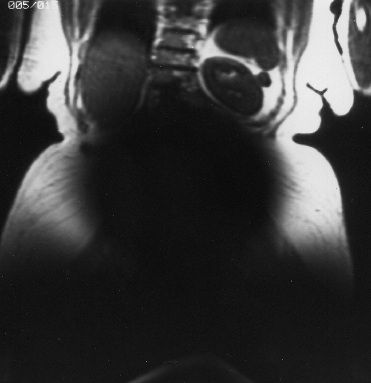Conductive elements in implantable device degrade MR image quality
A pessary is a small medical device or form of pharmaceutical preparation that is inserted into the vagina or rectum and held in place by the pelvic floor musculature.
A pessary is a small medical device or form of pharmaceutical preparation that is inserted into the vagina or rectum and held in place by the pelvic floor musculature. In some instances, a pessary may contain metal that allows it to be shaped to facilitate proper retention.
Typically, the pessary is a firm ring or similar structure that presses against the wall of the vagina and urethra to help reduce urinary leakage or another condition. It is an effective nonsurgical means of managing a number of gynecologic problems. Indications for the pessary include pelvic support defects such as uterine prolapse and vaginal prolapse, as well as stress urinary incontinence.
MRI information
A wide variety of pessary styles exist, including those made entirely from nonmetallic, nonconducting materials (e.g., plastic, silicone, or latex) as well as those that have metallic components. Obviously, those pessaries made from nonmetallic, nonconducting materials pose no problems for patients undergoing MRI procedures.

However, pessaries that have metallic components will cause substantial artifacts, as shown in Figure 1. To date, there are no reports of injuries or other issues related to performing MRI in patients with these devices.
Bibliography
Brubacker L. The vaginal pessary. In: Friedman AJ, ed. American Urogynecologic Society quarterly report, 1991;9(3).
Davila GW. Vaginal prolapse: management with nonsurgical techniques. Postgrad Med 1996;99:171-176,181,184-185.
Deger RB, Menzin AW, Mikuta JJ. The vaginal pessary: past and present. Postgrad Obstet Gynecol 1993;13:1-8.
Komesu YM, Ketai LH, Rogers RG, et al. Restoration of continence by pessaries: magnetic resonance imaging assessment of mechanism of action. Am J Obstet Gynecol 2008;198(5):563.e1-6.
Miller DS. Contemporary use of the pessary. In: Sciarra JJ, ed. Gynecology and obstetrics, revised 1997 ed. Philadelphia: Lippencott-Raven, 1997:1-12.
Shellock FG. Reference manual and for magnetic resonance safety, implants and devices: 2009 edition. Los Angeles: Biomedical Research Publishing Group, 2009; www.MRIsafetybook.com
Zeitlin MP, Lebherz TB. Pessaries in the geriatric patient. J Am Geriatr Soc 1992;40:635-639.
Frank G. Shellock, Ph.D., is an adjunct clinical professor of radiology and medicine at the Keck School of Medicine, University of Southern California. He is also the director of MRI studies at the Biomimetic Microelectronic Systems, National Science Foundation - Engineering Research Center, USC, the founder of the Institute for Magnetic Resonance Safety, Education, and Research (www.imrser.org), and president of Shellock R&D Services.
Could Ultrafast MRI Enhance Detection of Malignant Foci for Breast Cancer?
April 10th 2025In a new study involving over 120 women, nearly two-thirds of whom had a family history of breast cancer, ultrafast MRI findings revealed a 5 percent increase in malignancy risk for each second increase in the difference between lesion and background parenchymal enhancement (BPE) time to enhancement (TTE).
MRI Study Suggests Shape of White Matter Hyperintensities May Be Predictive of Cognitive Decline
April 7th 2025Emerging research demonstrated that cognitive declines in memory, executive function and processing speed domains were associated with irregular shape of periventricular/confluent white matter hyperintensities.
Can Abbreviated MRI Have an Impact in Rectal Cancer Staging?
April 4th 2025Abbreviated MRI demonstrated a 95.3 percent specificity for rectal cancer and provided strong agreement with the full MRI protocol for T staging and detection of extramural venous invasion, according to newly published research.